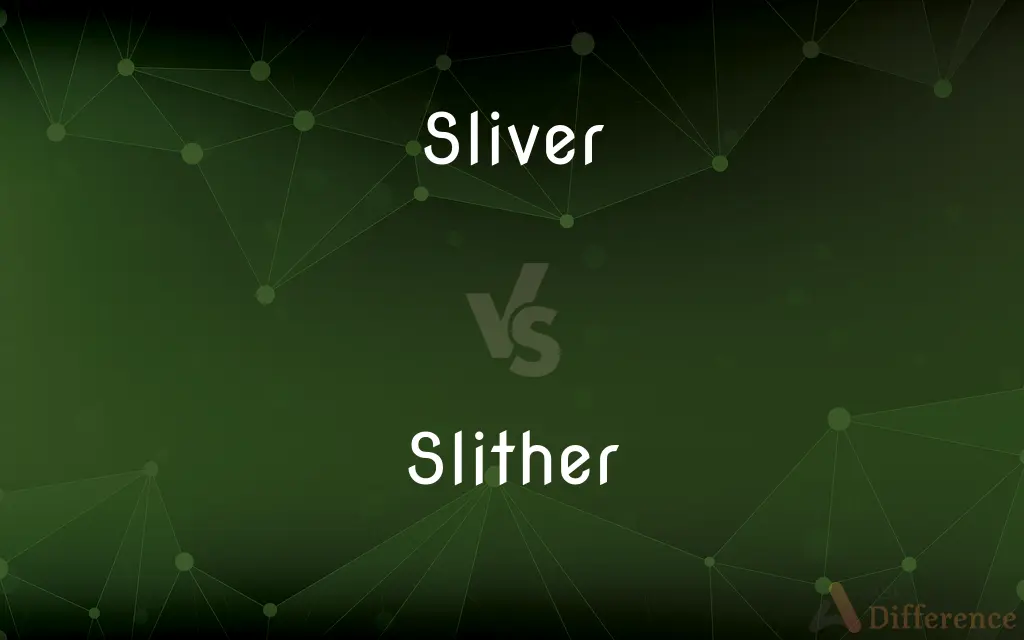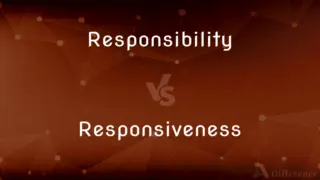Sliver vs. Slither — What's the Difference?
By Fiza Rafique & Maham Liaqat — Updated on March 18, 2024
Sliver refers to a small, thin piece cut or broken off, while slither describes a sliding, twisting movement.

Difference Between Sliver and Slither
Table of Contents
ADVERTISEMENT
Key Differences
A sliver is often a small, thin, and elongated piece of material that has been split or cut from a larger piece. It suggests a fragment that is sharp or delicate, such as a sliver of glass or wood. On the other hand, slither refers to the motion of moving smoothly over a surface with a twisting or oscillating motion, often associated with snakes or similar creatures.
The term sliver is commonly used to describe something that is physically small and narrow, emphasizing its fine or slender nature. This can apply to various materials and contexts, from a sliver of wood embedded in a finger to a sliver of moon in the night sky. In contrast, slither is used to describe a specific type of movement that is smooth, sinuous, and often silent, capturing the essence of stealth and fluidity.
In terms of usage, sliver is often found in contexts where precision and delicacy are implied, highlighting the fragile or minute nature of the piece in question. Slither, however, evokes a sense of undulating motion and can be used to describe the way certain animals move, the movement of water, or even the way a person might move in a stealthy or subtle manner.
When considering the physical implications, a sliver is something tangible that can be seen and touched, often requiring careful handling due to its sharp or delicate nature. Slither, as a verb, focuses on the action and manner of movement, suggesting a certain grace or stealthiness in the way something or someone moves across a surface.
The concept of a sliver is static, referring to an object's state or form, while slither is dynamic, emphasizing the action and manner of movement. This distinction highlights the difference between a physical object and an action or behavior.
ADVERTISEMENT
Comparison Chart
Definition
A small, thin, sharp piece split or broken off something
A smooth, twisting or oscillating movement
Context
Often associated with materials like wood or glass
Primarily related to the movement of creatures
Implication
Emphasizes the fine, delicate nature of the fragment
Suggests stealth, fluidity, and smoothness in motion
Physical Nature
Tangible object that can be seen and handled
Describes an action or manner of movement
Usage
Used to describe the physical characteristics of pieces
Used to describe the way entities move over surfaces
Compare with Definitions
Sliver
A small, thin piece of something.
She got a sliver of wood in her finger while handling the firewood.
Slither
Smooth, undulating movement in water.
The eel slithered through the narrow crevice.
Sliver
A tiny, often unexpected chance.
They clung to a sliver of hope as the rescue team arrived.
Slither
To move smoothly with a twisting motion.
The snake slithered across the forest floor.
Sliver
A tiny, sharp piece of glass.
He carefully removed a glass sliver from his foot.
Slither
The subtle movement of shadows.
Shadows seemed to slither along the walls as clouds moved past the moon.
Sliver
A narrow beam or streak of light.
A sliver of light peeked through the curtains at dawn.
Slither
The sound associated with smooth, sliding movement.
The slithering sound in the grass made her uneasy.
Sliver
A long, loose assembly of fibers in spinning.
The spinner fed a sliver of wool into the spinning wheel.
Slither
Moving quietly and stealthily.
The thief slithered through the dark alley, unnoticed.
Sliver
A slender piece cut, split, or broken off; a splinter
Slivers of broken glass.
Slither
To move or slide by twisting or undulating the body over a surface, as in the manner of a snake.
Sliver
A small narrow piece, portion, or plot
A sliver of land.
Slither
To walk with a sliding or shuffling gait
Slithered over to the window.
Sliver
A continuous strand of loose fiber, such as wool, flax, silk, or cotton, ready to be roved or spun.
Slither
To slip and slide, as on a loose or uneven surface
"We went slithering down the muddy rocks to sea level" (Jane Rodgers).
Sliver
To split or become split into slivers.
Slither
A slithering movement or gait.
Sliver
A long piece cut or rent off; a sharp, slender fragment; a splinter.
Slither
(intransitive) To move about smoothly and from side to side.
Sliver
(regional US) Specifically, a splinter caught under the skin.
Slither
(intransitive) To slide
Sliver
A strand, or slender roll, of cotton or other fiber in a loose, untwisted state, produced by a carding machine and ready for the roving or slubbing which precedes spinning.
Slither
(archaic) slithery; slippery
Sliver
(fishing) Bait made of pieces of small fish. Compare kibblings.
Slither
A limestone rubble.
Sliver
A narrow high-rise apartment building.
Slither
A sliver.
Sliver
A small amount of something; a drop in the bucket; a shred.
Slither
To slide; to glide.
Sliver
(transitive) To cut or divide into long, thin pieces, or into very small pieces; to cut or rend lengthwise; to slit.
To sliver wood
Slither
To pass or move unobtrusively or smoothly;
They slid through the wicket in the big gate
Sliver
To cut or divide into long, thin pieces, or into very small pieces; to cut or rend lengthwise; to slit; as, to sliver wood.
They 'll sliver thee like a turnip.
Sliver
A long piece cut or rent off; a sharp, slender fragment, as of glass; a splinter.
Sliver
A strand, or slender roll, of cotton or other fiber in a loose, untwisted state, produced by a carding machine and ready for the roving or slubbing which preceeds spinning.
Sliver
Bait made of pieces of small fish. Cf. Kibblings.
Sliver
A small thin sharp bit or wood or glass or metal;
He got a splinter in his finger
It flew into flinders
Sliver
A thin fragment or slice (especially of wood) that has been shaved from something
Sliver
Divide into slivers or splinters
Sliver
Break up into splinters or slivers;
The wood splintered
Sliver
Form into slivers;
Sliver wood
Common Curiosities
Is slither always related to snakes?
While commonly associated with snakes, slither can describe any smooth, twisting motion, even inanimate objects like water or shadows.
Can humans slither?
In a metaphorical sense, yes. Describing a person as slithering usually implies moving in a stealthy or subtly sinuous manner.
Can inanimate objects slither?
Metaphorically, yes. Descriptions like "the river slithered through the valley" use slither to convey a sinuous, flowing motion.
What types of materials can form a sliver?
Almost any material can form a sliver if it's capable of being split or broken into thin, sharp pieces, including metal, wood, glass, and even stone.
Does a sliver always imply a risk of injury?
Not always, but slivers, especially of materials like wood or glass, can pose a risk of cuts or embedding in the skin, requiring careful handling.
Is slither used only for animals?
Primarily, yes, especially for those that move without legs, like snakes or worms, but it can also metaphorically describe other smooth, gliding movements.
Can the term slither have a positive connotation?
It's less common, but in contexts like "the dancer slithered across the stage," it can imply grace and fluidity.
What distinguishes a sliver from a shard?
A sliver is a small, thin piece, often with delicate connotations, while a shard is typically a larger, more irregular fragment, often of glass or pottery.
Can the word sliver have a positive connotation?
Yes, in contexts like "a sliver of hope" or "a sliver of light," it can signify something small yet positive or promising.
How does one typically deal with a sliver of wood or glass?
Small slivers can often be removed with tweezers and the area cleaned to prevent infection, but medical advice may be needed for deeper or more serious cases.
Can sliver be used in a metaphorical sense?
Yes, sliver can be used metaphorically to describe a small portion or fraction of something, such as "a sliver of doubt" or "a sliver of truth."
How is sliver commonly used in the textile industry?
In textiles, a sliver refers to a loose, untwisted strand of fibers prepared for further processing, like spinning into yarn.
Are slivers always unintentional?
Often, but not always. In some cases, slivers, especially in crafting or manufacturing, can be intentionally created for specific purposes.
Is there a specific environment where slithering is most commonly observed?
Slithering is often associated with creatures in smooth, flat environments like grassy fields or desert sands, where this movement is advantageous.
What emotions can the action of slithering evoke?
Slithering often evokes feelings of unease or stealth, associated with silent, smooth movements that can be unexpected or hard to detect.
Share Your Discovery

Previous Comparison
Army vs. Military
Next Comparison
Responsibility vs. ResponsivenessAuthor Spotlight
Written by
Fiza RafiqueFiza Rafique is a skilled content writer at AskDifference.com, where she meticulously refines and enhances written pieces. Drawing from her vast editorial expertise, Fiza ensures clarity, accuracy, and precision in every article. Passionate about language, she continually seeks to elevate the quality of content for readers worldwide.
Co-written by
Maham Liaqat















































